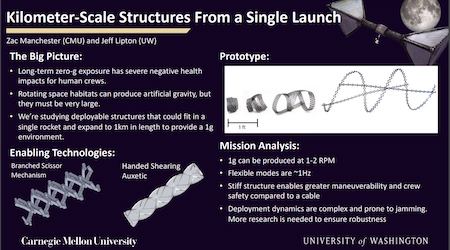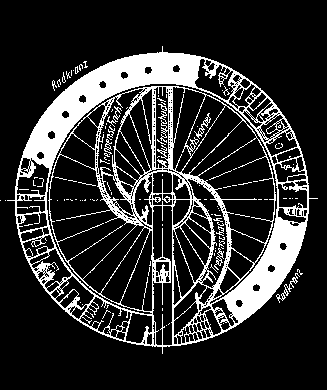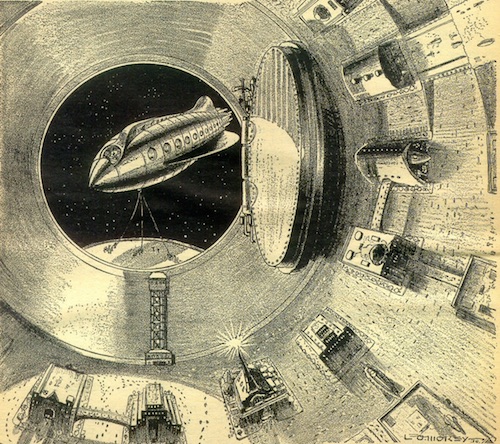Science Fiction
Dictionary
A B C D E F G H I J K L M N O P Q R S T U V W X Y Z
Kilometer-Wide Rotating Space Station On One Rocket

Is it possible to launch enormous (i.e. kilometer-wide) rotating space stations with a single rocket launch?

(Slide from a NIAC presentation)
Artificial gravity remains the stuff of science fiction. But dealing with no gravity causes significant problems in many astronauts, ranging from bone deterioration to loss of sight. An alternative method that might eliminate some of these problems is “simulated gravity,” which uses a spinning structure to create centrifugal force that would have the same effect on the body as gravity would. Whether or not this would solve the problems caused by lack of gravity remains to be seen. Still, NASA seems keen on the idea – to the tune of a $600,000 NASA Institute for Advanced Concepts (NIAC) Phase II grant to a team from Carnegie Mellon University (CMU) and the University of Washington (UW) who is looking to develop a structure that can simulate full Earth gravity and be launched in a single rocket.The project in question is “Kilometer-Scale Space Structure from a Single Launch,” which was initially admitted to the NIAC program last year. Over the past year, they successfully completed a Phase I project where they “analyze[d] a mission concept analogous to the Lunar Gateway” that could deploy into a kilometer-long structure. Having met NASA’s expectations as part of that program, the team, headed by professor Zac Manchester of CMU and Jeffery Lipton of UW, were recently accepted as 2022 NIAC fellows.
The idea of a rotating space station that provides artificial gravity goes back to at least 1928. This same idea is stated in detail in The Problem of Space Travel - The Rocket Motor, written by Herman Potočnik (pseudonym Hermann Noordung) in 1928. The book was published in German in 1929, and was translated into Russian in 1935; it was finally translated into english by NASA in 1999).

(Herman Potočnik Habitat Wheel (author's illustration))
These conditions are, however, best fulfilled when the station is laid out in the shape of a large wheel as previously indicated: the rim of the wheel is composed out of cells and has the form of a ring braced by wire spokes towards the axis. Its interior is separated into individual rooms by partitions; all rooms are accessible from a wide corridor going around the entire station. There are individual rooms, larger sleeping bays, work and study areas, mess hall, laboratory, workshop, dark room, etc., as well as the usual utility areas, such as a kitchen, bath room, laundry room and similar areas. All rooms are furnished with modern day comforts; even cold and warm water lines are available. In general, the rooms are similar to those of a modern ship. They can be furnished just like on Earth because an almost normal, terrestrial gravitational state exists in these rooms...
Science fiction writer Jack Williamson made use of the idea in his 1931 story The Prince of Space:
(The city of space by Jack Williamson)"They were, Bill saw, at the center of an enormous cylinder. The sides, half a mile away, above and below them, were covered with buildings along neat, tree-bordered streets, scattered with green lawns, tiny gardens, and bits of wooded park. It seemed very strange to Bill, to see these endless streets about the inside of a tube, so that one by walking a little over three miles in one direction would arrive again at the starting point, in the same way that one gets back to the starting point after going around the earth in one direction."
Launching huge structures at one time is no big strain (for the imagination, at least) for science fiction authors. Read about the flywheel launcher sufficient to send a brick moon into space in Edward Everett Hale's 1869 story The Brick Moon:
('The Brick Moon' by Edward Everett Hale)"It was not to be by any of your sudden explosions. It was to be done as all great things are done,--by the gradual and silent accumulation of power. You all know that a flywheel--heavy, very heavy on the circumference, light, very light within it--was made to save up power, from the time when it was produced to the time when it was wanted. Yes? Then, before we began even to build the moon, before we even began to make the brick, we would build two gigantic fly-wheels, the diameter of each should be "ever so great," the circumference heavy beyond all precedent, and thundering strong, so that no temptation might burst it. They should revolve, their edges nearly touching, in opposite directions, for years, if it were necessary, to accumulate power, driven by some waterfall now wasted to the world."
Scroll down for more stories in the same category. (Story submitted 3/7/2022)
Follow this kind of news @Technovelgy.| Email | RSS | Blog It | Stumble | del.icio.us | Digg | Reddit |
Would
you like to contribute a story tip?
It's easy:
Get the URL of the story, and the related sf author, and add
it here.
Comment/Join discussion ( 0 )
Related News Stories - (" Space Tech ")
Will Space Stations Have Large Interior Spaces Again?
'They filed clumsily into the battleroom, like children in a swimming pool for the first time, clinging to the handholds along the side.' - Orson Scott Card, 1985.
Reflect Orbital Offers 'Sunlight on Demand' And Light Pollution
'I don't have to tell you about the seven two-mile-diameter orbital mirrors...'
Chrysalis Generation Ship to Alpha Centauri
'This was their world, their planet —
this swift-traveling, yet seemingly moveless vessel.' - Nat Schachner, 1934
The First Space Warship For Space Force
'Each of the electrical ships carried about twenty men...' - Garrett P. Serviss, 1898.
Technovelgy (that's tech-novel-gee!) is devoted to the creative science inventions and ideas of sf authors. Look for the Invention Category that interests you, the Glossary, the Invention Timeline, or see what's New.
Science Fiction
Timeline
1600-1899
1900-1939
1940's 1950's
1960's 1970's
1980's 1990's
2000's 2010's
Current News
The Zapata Air Scooter Would Be Great In A Science Fiction Story
'Betty's slapdash style.'
Thermostabilized Wet Meat Product (NASA Prototype)
There are no orbiting Michelin stars. Yet.
Could Crystal Batteries Generate Power For Centuries?
'Power could be compressed thus into an inch-square cube of what looked like blue-white ice'
India Ponders Always-On Smartphone Location Tracking
'It is necessary... for your own protection.'
Amazon Will Send You Heinlein's Knockdown Cabin
'It's so light that you can set it up in five minutes by yourself...'
Is It Time To Forbid Human Driving?
'Heavy penalties... were to be applied to any one found driving manually-controlled machines.'
Replace The Smartphone With A Connected Edge Node For AI Inference
'Buy a Little Dingbat... electropen, wrist watch, pocketphone, pocket radio, billfold ... all in one.'
Artificial Skin For Robots Is Coming Right Along
'... an elastic, tinted material that had all the feel and appearance of human flesh and epidermis.'
Robot Guard Dog On Duty
I might also be thinking of K-9 from Doctor Who.
Wearable Artificial Fabric Muscles
'It is remarkable that the long leverages of their machines are in most cases actuated by a sort of sham musculature...'
BrainBridge Concept Transplant Of Human Head Proposed
'Briquet’s head seemed to think that to find and attach a new body to her head was as easy as to fit and sew a new dress.'
Google's Nano Banana Pro Presents Handwritten Math Solutions
'...copy was turned out in a charming and entirely feminine handwriting.'
Edible Meat-Like Fungus Like Barbara Hambly's Slunch?
'It was almost unheard of for slunch to spread that fast...'
Sunday Robotics 'Memo' Bot Has Unique Training Glove
'He then started hand movements of definite pattern...'
Woman Marries Computer, Vonnegut's Dream Comes True
'Men are made of protoplasm... Lasts forever.'
Natural Gait With Prosthetic Connected To Nervous System
'The leg was to function, in a way, as a servo-mechanism operated by Larry’s brain...'


